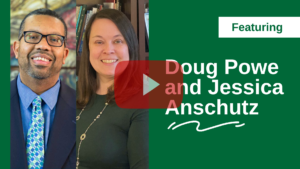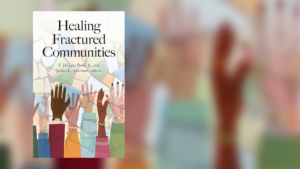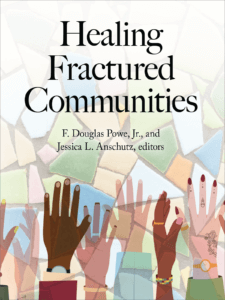
How can congregational leaders be both healers and agitators at the same time, especially given our fractured landscape and the diversity of contexts where congregations exist? Doug Powe and Jessica Anschutz reflect on the book, Healing Fractured Communities, in which pastoral leaders write about their experiences with renewal, resilience, and resistance in congregations, on college campuses, and in communities.
Listen on Apple Podcasts | Google Podcasts | Spotify
Watch on YouTube

Read in-depth interview
- Transcript — Click or Tap to Read
-
Announcer: Leading Ideas Talks is brought to you by the Lewis Center for Leadership of Wesley Theological Seminary in Washington, DC. Subscribe free to our weekly e-newsletter, Leading Ideas, at churchleadership.com/leadingideas.
Leading Ideas Talks is also brought to you by Healing Fractured Communities, a book written by alumni of the Lewis Center Community Leadership Fellows program. Each chapter paints a picture of the work of healing fractures like racism, education inequality, and poverty. Each chapter also includes takeaways to inspire healing in your community plus questions for reflection. All proceeds support the Dr. Lovett H. Weems Jr. Scholarship Fund. Learn more and order now at churchleadership.com/books.
How can congregational leaders be both healers and agitators at the same time, especially given our fractured landscape and the diversity of contexts where congregations exist? Doug Powe and Jessica Anschutz reflect on the book, Healing Fractured Communities, in which pastoral leaders write about their experiences with renewal, resilience, and resistance in congregations, on college campuses, and in communities.
Ann Michel: Welcome to Leading Ideas Talks! I’m Ann Michel. I’m a senior consultant with the Lewis Center for Church Leadership and I’m also one of the editors of Leading Ideas e-newsletter. I’m pleased to be your host for this episode of our podcast. I have the privilege today of being in conversation with two of my Lewis Center colleagues: Dr. F. Douglas Powe Jr. and Dr. Jessica Anschutz. They are Director and Assistant Director, respectively, of the Lewis Center. If you listen to our podcast regularly, you’re used to hearing them as hosts and interviewers, but today they are my guests, and they’re here to discuss a new book that they have pulled together and edited called Healing Fractured Communities. It’s an exciting book, and I’m so happy to welcome you guys to the conversation today.
Doug Powe: It is great to be with you, Ann.
Ann Michel: Doug, let me start with you. Can you explain a little bit about this book, how it came to be and who’s been part of the process?
Doug Powe: Absolutely. This project came out of our work through a grant from the Lilly Endowment, Inc. Through the grant, we created a series of Lewis Community Leadership Fellows cohorts. We had, overall, eight cohorts of Lewis Community Fellows. And the idea behind this was to help leaders better engage their community, to be able to think about and deeply engage a context, and to be able to collaborate with different individuals in their context like civic leaders, business leaders, and others who are critical for the work of the church.
As we got near the end of the project, we wanted to make sure we could capture in a good way a lot of the good work that was being done by these Fellows. So, the idea of the book came about to capture some of the powerful work that was being done. We would have loved of course to have every single Fellow write something, but of course that would not be possible. So, we worked with six Fellows to pull this together. And these Fellows were in various contexts, ranging from rural to a college ministry setting to your typical sort of urban or suburban settings. I think both Jessica and I found working with them really fun and exciting, and they did excellent work.
Ann Michel: You’ve mentioned that the six contributing authors came from a variety of different ministry contexts and faced a variety of different challenges. Jessica, could you expand on that a bit and just say a little bit about the specific situations that are addressed in this book?
Jessica Anschutz: Sure, I’d be glad to. Each of the authors is serving as United Methodist clergy, and they serve in a variety of different appointment contexts, as Doug alluded. One of the authors serves a congregation that’s on the border between the United States and Mexico. She talks about her work on the border and moving the congregation beyond the walls of the church and also across the border. A couple of the authors are in suburban contexts. One writes about her ministry both in Arkansas and in Maryland in congregations struggling to see the poor in their midst. Another is in a rural context in Missouri. We have one who’s serving in a multicultural, multiracial appointment in New Jersey, and another of the pastors serves in campus ministry. So, while we don’t cover all possible contexts, we do have a range of contexts that are covered by the book.
Ann Michel: I was really surprised by the diversity of settings these different pastors were dealing with, yet this theme of “healing fractured communities” really emerged as a theme that I think relates to all their work. Doug, I wondered if you could say a bit about how you chose the theme of healing fractured communities not just for the book but for the work of the Lewis Community Leadership Fellows overall.
Doug Powe: That theme emerged out of the thinking behind the project as a whole. When we started, for several years the Fellows met in Baltimore. In Baltimore, like in any major city, there was racial tension. That tension of course created fractures in various places within the city. So, when the Fellows would go to Baltimore, they had the opportunity to talk with pastors who were working on that issue of racial tension. They actually got to talk with police officers and elected officials. It was looking at that theme of racial tension and the fractures caused in a major city and thinking about how we as church leaders can help bring healing to that sort of context. We also would look at the issues of education and housing in different contexts.
Looking at these issues, the same theme emerged. There are fractures around how you do affordable housing. What are the best approaches? Who’s impacted by these sorts of things? And you could go on and on about the different fractures that are caused by various themes, even as they go back to their own communities. As we thought about the book, what we wanted to capture was how leaders can think about particular themes and address these within their context and bring healing or help to bring healing to those contexts. These things of course are huge social issues, so we realized that you’re not going to solve them easily. But the hope is that the work of the church is to bring healing or be a balm in these various situations, so the book really addresses how we create healing in those various contexts.
Ann Michel: My tenure with the Lewis Center actually predates Doug’s, and I had worked with this program in its earliest iterations. He mentioned going to Baltimore; that almost happened by accident. We had the Fellows meeting in Washington, talking about community redevelopment and affordable housing, and it just so happened that the group was in Washington when the Freddie Gray murder happened in Baltimore. We were here in Washington thinking about how churches can engage the community, and an hour up the road Baltimore was literally on fire and we’re like, “This is where we need to be with this group.”
I wanted to ask both of you if there’s one particular story or vignette from this book that really resonated with you personally. Let me turn to Jessica first and then I’ll go to Doug.
Jessica Anschutz: That’s a really great yet challenging question, Ann, as there are aspects of each of the stories that resonated with me and my experiences in ministry. I think today, right now, I’ll choose a story from chapter 2 where Julius Wardley writes about his experience in campus ministry and engaging with students who are experiencing poverty. He tells a story about Food for Thought, which was the Wesley Foundation food bank where he was serving. He helped carry groceries to a car for a young mother and, when he arrived at the car, he realized that it was overflowing with trash bags that were filled with her personal belongings and that she was working really hard to make a better life for herself and for her children. I served in campus ministry for four years prior to entering ministry, and this story reminded me of so many people I encountered in my experiences in ministry, both on a college campus and in the churches that I served. Often when we are building relationships with people, we learn more about what’s happening in their lives under the surface than what has been presented initially. We learn about their challenges, their vulnerabilities, as we develop those relationships, which then of course allows us to better respond and begin to take steps toward healing. Right now, that’s the story that jumps out at me today.
Ann Michel: You know, it’s funny. That’s the story I would have chosen, too. We don’t think about there being poverty among university students, and it was so eye-opening to read about the fact that, among his campus ministry, participants were people really struggling with homelessness, food insecurity, poverty, and employment issues that really had to become the focus of campus ministry. It was a really interesting story. How about you, Doug?
Doug Powe: Before I answer, I just want to add to that story. What I think is helpful in that chapter is when Julius talks about how congregations can get involved in that work. It’s not just campus ministry. Congregations can actually partner or play an important role in healing what is a fracture in the community. And it’s something that is often under the radar for most of us because we just assume that, when you’re in college, you have housing, you have food. The reality is that it’s just not true today in the way it may have been in the past, so I really appreciated that story as well.
But I’m going to choose a different story. I was really struck by Rev. Iraida [Ruiz de Porras] who is in a multicultural setting and a female pastor and who just really shares in a compelling way the challenges of multicultural ministry. People often talk today about the importance of multicultural ministry and wanting people to do this sort of work, but she really opens our eyes to just how difficult this work can be. It is just not easy to get congregations that have been brought up in different traditions to really share a space together and to worship one Christian God in a way that they both feel they are getting filled by the Spirit.
The really wonderful part is near the end of the chapter where she talks about a hymn sing. A hymn sing was one of the ways she was able to create a space for them to come together and where both congregations really felt appreciated and could appreciate one another even amidst all the challenges, and the challenges, again, are ongoing. This doesn’t solve the issue of what’s taking place. But the beauty of the hymn sing is at least creating that space where they actually could appreciate each other and find a way that they could worship together. It was really touching.

The new book Healing Fractured Communities is written by alumni of the Lewis Center Community Leadership Fellows program who are pastoral leaders engaged in the work of renewal, resilience, and resistance in congregations, on college campuses, and in communities. Each chapter paints a picture of the work of healing fractures like racism, education inequality, and/or poverty. Each chapter includes takeaways to inspire healing in your community, and questions for reflection. Proceeds from the sale of the book support the Dr. Lovett H. Weems Jr. Scholarship Fund. Learn more and order now at churchleadership.com/books.
Ann Michel: I’m glad you highlighted that example because it reminds me that among these stories are stories of healing divides within congregations not just divides between the congregation and the community. Doug, there are some common threads that run across these various experiences of healing fractured communities. And the book develops the themes of resilience, resistance, and renewal. I wondered if you could very briefly describe how those key elements of change relate to this work of healing fractured communities.
Doug Powe: Absolutely. Anytime you’re a leader, particularly in a congregation, we believe that these three R’s are probably going to be a part of your ministry in some form or fashion. First, resilience — a congregation is really having to be resilient particularly today when coming out of COVID. They might be in the midst of decline. They might be in other transitions. So, it is critically important that the leader really helps the congregation to be resilient in the face of whatever they may be facing. And it really takes a certain leadership to help the congregation recognize the importance of that resilience.
In terms of renewal, we use that term so often in the church to talk about congregational renewal. But in our case, we’re actually thinking about it more in the Romans 12:2 way of “renewing your mind.” Congregations have to create a different mindset. You can’t just be a standalone entity as we often thought of ourselves in the past. Collaborations are necessary. You’re going to have to create a mindset that you’re going to have to do things differently in the congregation. In this case, renewal is really about that different mindset.
Resistance probably is the one that seems different, but resistance is key because a part of the work that we have to do as congregations is resisting the evil powers and resisting those things that can create the fractures in the community. That resistance is critical for the work of healing, so having the courage to empower people to have the courage for resistance is important.
Ann Michel: I recall reading in the first chapter of the book about the congregation in the U.S.–Mexican border town that resistance doesn’t necessarily have to mean coming to blows. There can be small, strategic acts of resistance that can help congregations heal. That was a helpful bit of learning for me in the book. Again, one of the things I found so fascinating about this book is that, even though the contributing authors were addressing such different contexts and dealing with very different challenges and realities, there were common themes and common lessons that emerged. I wonder, Jessica, if you could name a couple of the learnings that you think emerge from this book that others can learn.
Jessica Anschutz: Sure, I’d be glad to. Thank you, Ann. I’ve already alluded to one of them, and that is the importance of building relationships, and that relates to the congregational context within the community and beyond. In a couple of places, we learn about the small steps of learning someone’s name. Whether it’s the person sitting next to you in the pew or learning the name of the people who are coming to the food pantry or learning the names of the folks who are across the border in Mexico, and then how starting with one relationship can begin to transform the community. And a part of that also, I think, is that each of the authors understood themselves to be leader and teacher but also a student. They were coming alongside and learning. And I think that’s really important in sort of the mutuality of relationships.
Another theme that I will pick up on — it’s one of my favorites — is “attending to the elephant in the room” or, as we say in the book, “the chicken in the room,” because Joel [Kidwell] tells a story about bringing change to an annual chicken dinner in his congregation, which is where the chicken comes from in that phrase. And again, sometimes what appears on the surface can be indicative of deeper issues.
Iraida lifts up resistance to multilingual and bilingual worship services and sermons and points out that it’s not simply resistance to those experiences. Some of those feelings and actions may be rooted in injustice and prejudice and discrimination. Naming the elephant or the chicken in the room is part of the painful and hard work of truth telling and a necessary step toward healing in congregations and in ministry.
Ann Michel: This really is a very inspiring book in large part because it addresses real life ministry situations and real life community challenges. And even if the situations described in the book don’t precisely match your situation, I think that these stories are so authentic and the lessons are so broadly applicable that I think everybody can find inspiration in reading about how these various pastors went about their work and were able to achieve healing, which is the goal of this program.
So, to begin to draw this to a close, I’d like to ask first: If someone’s interested in this book, how can they get a copy of it?
Jessica Anschutz: Great question. The book is currently available on Amazon in both softcover and e-book formats. It’s also available at Barnes & Noble. And we have plenty of copies here at the Lewis Center that can be ordered if you go to churchleadership.com and visit our online store.
Ann Michel: Finally, since this book really highlights the experiences of pastors who’ve taken part in this Lewis Community Leadership Fellows Program, I wondered, Doug, if you could say a word to people who might be interested in our Lewis Fellows learning experiences.
Doug Powe: Absolutely. The Lewis Fellows — I’m using the term broadly in this case — have been a critical part of what the Lewis Center has done over the years. We actually just started a new Lewis Fellows cohort that we’re really excited about. It is off to a great start, but our plan is to continue to fund the Lewis Fellows program out of the Lewis Center itself. So, all the proceeds from the book actually are going towards continuing to fund that program. When you purchase a book, you’re actually helping pastors develop their leadership skills.
We think that work is important, and we appreciate the authors contributing. Because they benefited from the program, they will be supporting pastors in the future who will benefit from the program. We think that the Lewis Fellows have helped numerous pastors really develop critical leadership skills. Many of them are doing wonderful things not only in the United Methodist Church but across denominations. I think our track record in this area has been really strong.
Ann Michel: I want to thank both of you for the work that you’ve done with these Lewis Community Leadership Fellows in helping them bring their stories to press so that others can learn from their experience. I think it’s a wonderful way to expand the impact of the wonderful Lewis Community Leadership Fellows. Again, the book is Healing Fractured Communities.
Announcer: Thank you for joining us for Leading Ideas Talks.
Don’t forget to subscribe to our free weekly e-newsletter, Leading Ideas, to be notified when new episodes are published. Visit churchleadership.com/leadingideas.
Healing Fractured Communities is available at the Lewis Center shop.
Related Resources
- 4 Key Characteristics of Missional Congregations by Doug Powe
- Sustaining While Disrupting with Doug Powe and Lovett Weems
- Listening to Your Community by Paul Nixon
Photo by Renzo D’souza on Unsplash




